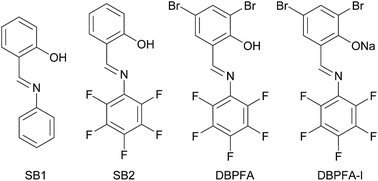Highly emissive salicylidene Schiff bases (SASBs) in solution and their application in the detection of the chemical warfare agent mimic diethyl chlorophosphate†
Abstract
Salicylidene Schiff bases (SASBs) have attracted significant attention because they have unique properties and can be simply synthesized by the condensation reactions; however, their poor fluorescence in solution makes them unable to be used as a fluorescent turn-off probe and limits their application fields. Herein, we have endeavoured to design and synthesize salicylidene Schiff bases with strong fluorescence in solution by structural modification. We found that although 3,5-dibromosalicylidene 2,3,4,5,6-pentafluoroaniline (DBPFA) showed very poor luminescence properties in solution, when it was reacted with NaOH to afford DBPFA-I at the same concentration, the emission intensity of DBPFA-I was 3890 times that of DBPFA. DBPFA-I could be used for detection of the nerve agent sarin mimic diethyl chlorophosphate (DCP) via nucleophilic attack of phenolic anion to DCP. The detection limit of the probe could be as low as 1.94 nM, which was much lower than other detection results. In addition, a paper strip device of DBPFA-I became non emissive immediately (in <15 s) upon exposure to DCP vapour (132 ppm (v/v)) with excellent selectivity. The sensing mechanism was explored by analyzing the sample via mass spectrometry.

- This article is part of the themed collection: Analytical Methods Recent HOT articles


 Please wait while we load your content...
Please wait while we load your content...